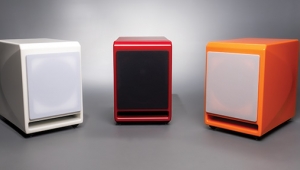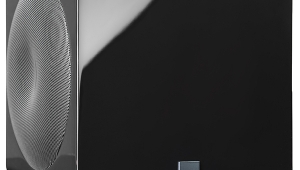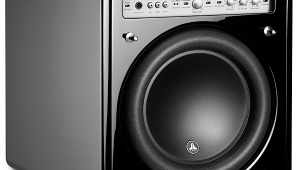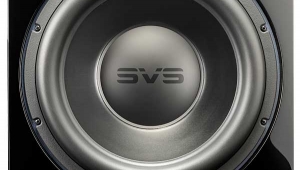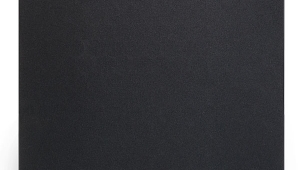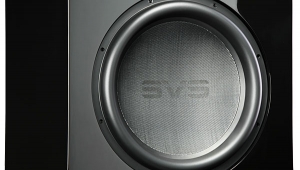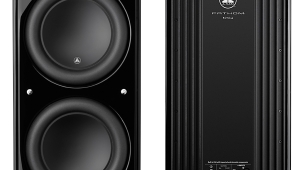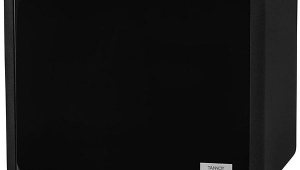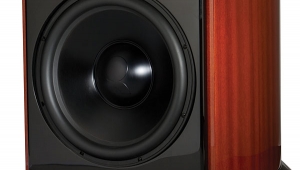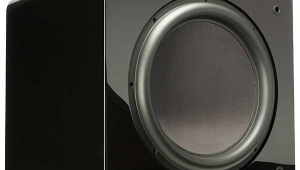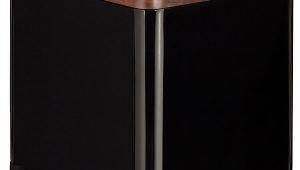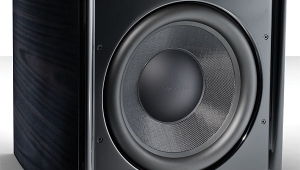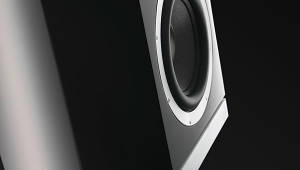| Columns Retired Columns & Blogs |
Audio Physic Rhea powered subwoofer Page 2
The Rhea includes two controls to deal with "room gain." One adjusts for the amount of increase in level below the standing-wave mode, and the other compensates for the frequency at which the pressurization occurs in the room. In other words, the first deals with "room stiffness," the second with room size. The "stiffer" the room—ie, the less the walls flex—the greater will be the amplitude rise below the pressurization frequency. The more the walls flex, the more "leakage" of low bass into the outside world. The smaller the room, the higher the frequency at which pressurization occurs. Basically, one adjustment controls the LF rolloff frequency, which should be set to the frequency at which the room begins to pressurize. The other controls the LF rolloff slope, the severity of which depends on the amount of leakage. In a perfectly stiff room, according to Theiss, the gain would be 12dB/octave. In actual rooms, the gain varies from between 3dB and 9dB/octave.
There's also a three-position high-frequency rolloff control (35Hz, 46Hz, or 61Hz) and an overall level potentiometer. The cabinet walls are of two layers of medium-density fiberboard with a foam layer in between. There's also a diffuser board inside to discourage internal standing waves and to increase rigidity.
Hookup is easy via four banana-plug inputs. Audio Physic claims that cable quality is not an issue, given the high input impedance and low frequencies involved, and that any "decent" low-capacitance cable will suffice. Somewhat more difficult, as you might imagine, is "dialing in" the subwoofer—while this can be done by the purchaser, it's best left to the dealer. Thus the room-size and room-stiffness controls are left unmarked, and are accessible only through tiny holes drilled through the heatsink backplate between two fairly deep fins set close together. The message is clear: Audio Physic would prefer you didn't mess with these controls once they're set, though they do provide instructions should you wish to.
In my room
Yes—my, er, room is fairly small (about 12' by 16', with a longer L-shaped dimension), and my walls could use a dose of Viagra. The floor is carpet over concrete (good), the ceiling is dropped (bad). When I moved in, I filled the space between the ceiling and the floor above it with Fiberglas insulation. (Never do this yourself, unless you can't afford to pay someone else to do it. If you can't, wear a good respirator and cover every inch of exposed skin. I did.)
The room is crammed with LPs, CDs, press kits, dog hair, etc., and looks like a sonic disaster. But as anyone who's taken the time to actually sit here and listen can attest, it works pretty well. Like most of you, I live in the real world, not the ideal one of dedicated listening-room bliss. Half the fun of this hobby is getting great sound from a seemingly impossible situation (or at least that's my rationalization for not having unlimited funds). As the Rhea is designed to work in just such an "impossible" room, what better test of this subwoofer could there be?
Placement was simple: in one corner behind the main speakers. It took a few hours' worth of diddling with test discs and music to get the room size'n'stiffness controls adjusted (done for me by Audio Physic chief Joachim Gerhard and importer Allen Perkins—the latter trains all AP dealers) so that the sub didn't sound overbearing—or even audible, for that matter. But once set, those controls didn't have to be touched again, no matter what main speakers I used. Because the room's size and stiffness never changed, whenever I changed L/R speakers, only level and high-frequency rolloff needed adjusting.
I used the Rhea with the Audio Physic Virgos, the Sonus Faber Concert Grand Pianos, and with a pair of the excellent and ridiculously inexpensive NHT Super Ones. With all of these speakers, the Rhea basically didn't "sound." In fact, when it was first set up, I was profoundly disappointed—I heard nothing. I couldn't understand what the point was until I went up to the attic to get something and found that the windows there were rattling from the bass three floors below!
Since AP's Virgos go down to about 30Hz (John Atkinson measured them as flat to 31.5Hz) and there isn't much musical information below that, what do you get for your $6000? Well, unlike many mere woofers that are marketed as subwoofers, the Rhea is a true subwoofer—it went down as far as can be recorded. If you're interested in hearing the subway that runs under Kingsway Hall, well, it did that for me. Not musically important, of course, but to get that kind of clean, focused, ultradeep bass in a small space, and not have it excite the room or interfere with the music no matter how loud you play it, is quite an accomplishment. It's indicative of how precisely the Rhea can be adjusted to work seamlessly in your room, no matter how large, small, boomy, or dry it might be.
When the Rhea was properly dialed in, it never thickened or slowed kickdrums or acoustic bass. It didn't attach itself to baritone voices. I wondered whether it was doing anything until I played some music that contains really deep, fundamental bass tones—like "Can't You Hear Me Knocking" on Mobile Fidelity's LP of the Rolling Stones' Sticky Fingers (MFSL 1-060), or "Shape of Things" on Jeff Beck's Truth—especially an original British Columbia pressing—or the Beatles' "Everybody's Got Something to Hide Except Me and My Monkey," on a British Apple pressing of The Beatles. Then, the Rhea hit me where it hurt. Where I want to be hurt.
Check out any well-recorded version of Saint-Sans' "Organ" Symphony (Paray/Detroit on Mercury SR 900012, Munch/BSO on RCA LSC-2341, Fremaux/City of Birmingham SO on Klavier KS 526). When the 32Hz organ pedal kicks in in the finale, I knew it! Even in my tiny room.
But more important than its ability to reproduce the deepest musical notes coherently and without added thickness or heaviness was the Rhea's ability to create the illusion of a large space in a small room. This is what impresses most listeners about the sound of my system. In my small room, the Rhea made the illusion of a large venue believable and effortless.
When I listened to any well-recorded symphonic work or live album—like those recorded at Carnegie Hall—a huge space was created before me. The Rhea never gave away its presence. When I turned it off, the sound closed down and the venue dried up, but little else changed if there was no deep bass in the music. I tried MoFi's LPs of Little Feat's Waiting for Columbus (MFSL2-013), recorded live. It starts with the Feat walking down a long, narrow corridor under the stadium. As they approach from way back, passing a joint, they begin their pre-show harmonizing. With the Rhea on, the confines of the narrow corridor were precisely delineated. With the Rhea off, the space disappeared.
When the band entered the stadium, that airy space expanded beyond the confines of my room. When Richie Hayward hit his amplified drumkit there was an explosion of focused, impossibly deep and dynamic bass—but the Rhea wasn't there. When the band fired into "Fat Man in the Bathtub," the walls disintegrated and I was sitting almost at the stage's edge. When I turned the Rhea off the sound was still damn good, but not nearly as dynamic, effortless, and big—or as convincing.
With the Rhea, deep bass was not a "sound effect" tacked onto the presentation—not some runaway low-frequency bump that popped into the picture at unwelcome times and was in need of taming and manipulation from record to record. Once properly set up, the Rhea didn't need to be touched. I didn't find it heavyhanded on one recording and not effective enough on another. Instead, thanks to its sonic "invisibility" and adjustability, the Rhea fit the bottom octaves into the system like the final, seamlessly fitting piece in a complex jigsaw puzzle of sound. It did it with the Audio Physic Virgos, the Sonus Faber Concert Grand Pianos, and even with the inexpensive NHT Super Ones. I never knew it was working until I turned it off.
Conclusion
At $6000, the Audio Physic Rhea is expensive, but it is exquisitely designed and built. Its flexible, room-friendly adjustability allows it to be paired with any number of bass-shy speakers to ensure placement flexibility, ideal soundstaging and imaging, and superb deep-bass performance—even in "impossible" rooms. Audio Physic's $3000 Luna subwoofer, far smaller and less obtrusive than the Rhea, offers the same basic design and 10Hz low-frequency performance, but doesn't play as loud. Audio Physic and Immedia claim it would be more than adequate for my listening room, and for most rooms of normal size. Think of the pairing possibilities—getting those bottom octaves and getting them right is expensive and tricky, but once you have them, doing without is not an option.
- Log in or register to post comments
